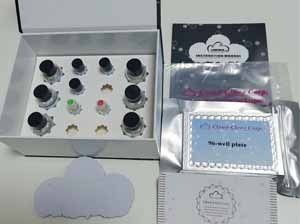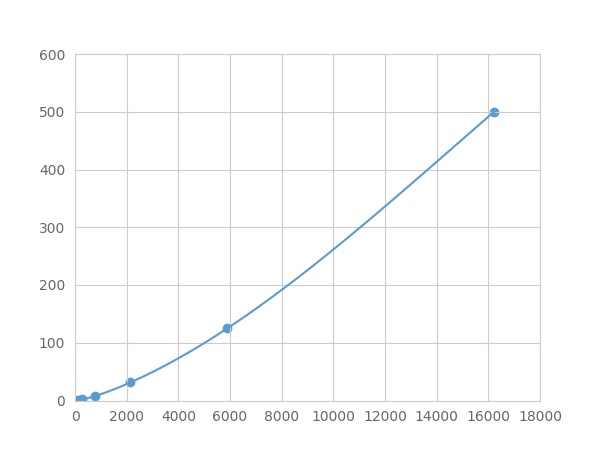Multiplex Assay Kit for Interleukin 13 (IL13) ,etc. by FLIA (Flow Luminescence Immunoassay) 

ALRH; BHR1; P600; IL-13; NC30
(Note: Up to 8-plex in one testing reaction)
- UOM
- FOB US$ 483.00 US$ 502.00 US$ 530.00 US$ 567.00 US$ 604.00 US$ 660.00 US$ 743.00 US$ 929.00
- Quantity
Overview
Properties
- Product No.LMA060Eq
- Organism SpeciesEquus caballus; Equine (Horse) Same name, Different species.
- ApplicationsFLIA Kit for Antigen Detection.
Research use only - DownloadInstruction Manual
- CategoryCytokineInfection immunity
Sign into your account
Share a new citation as an author
Upload your experimental result
Review

Contact us
Please fill in the blank.
Recovery
Matrices listed below were spiked with certain level of recombinant Interleukin 13 (IL13) ,etc. by FLIA (Flow Luminescence Immunoassay) and the recovery rates were calculated by comparing the measured value to the expected amount of Interleukin 13 (IL13) ,etc. by FLIA (Flow Luminescence Immunoassay) in samples.
| Matrix | Recovery range (%) | Average(%) |
| serum(n=5) | 80-98 | 90 |
| EDTA plasma(n=5) | 89-103 | 96 |
| heparin plasma(n=5) | 78-93 | 87 |
Precision
Intra-assay Precision (Precision within an assay): 3 samples with low, middle and high level Interleukin 13 (IL13) ,etc. by FLIA (Flow Luminescence Immunoassay) were tested 20 times on one plate, respectively.
Inter-assay Precision (Precision between assays): 3 samples with low, middle and high level Interleukin 13 (IL13) ,etc. by FLIA (Flow Luminescence Immunoassay) were tested on 3 different plates, 8 replicates in each plate.
CV(%) = SD/meanX100
Intra-Assay: CV<10%
Inter-Assay: CV<12%
Linearity
The linearity of the kit was assayed by testing samples spiked with appropriate concentration of Interleukin 13 (IL13) ,etc. by FLIA (Flow Luminescence Immunoassay) and their serial dilutions. The results were demonstrated by the percentage of calculated concentration to the expected.
| Sample | 1:2 | 1:4 | 1:8 | 1:16 |
| serum(n=5) | 90-97% | 89-102% | 88-95% | 92-101% |
| EDTA plasma(n=5) | 90-102% | 78-102% | 81-91% | 93-105% |
| heparin plasma(n=5) | 78-90% | 99-105% | 85-103% | 93-101% |
Stability
The stability of kit is determined by the loss rate of activity. The loss rate of this kit is less than 5% within the expiration date under appropriate storage condition.
To minimize extra influence on the performance, operation procedures and lab conditions, especially room temperature, air humidity, incubator temperature should be strictly controlled. It is also strongly suggested that the whole assay is performed by the same operator from the beginning to the end.
Reagents and materials provided
| Reagents | Quantity | Reagents | Quantity |
| 96-well plate | 1 | Plate sealer for 96 wells | 4 |
| Pre-Mixed Standard | 2 | Standard Diluent | 1×20mL |
| Pre-Mixed Magnetic beads (22#:IL13) | 1 | Analysis buffer | 1×20mL |
| Pre-Mixed Detection Reagent A | 1×120μL | Assay Diluent A | 1×12mL |
| Detection Reagent B (PE-SA) | 1×120μL | Assay Diluent B | 1×12mL |
| Sheath Fluid | 1×10mL | Wash Buffer (30 × concentrate) | 1×20mL |
| Instruction manual | 1 |
Assay procedure summary
1. Preparation of standards, reagents and samples before the experiment;
2. Add 100μL standard or sample to each well,
add 10μL magnetic beads, and incubate 90min at 37°C on shaker;
3. Remove liquid on magnetic frame, add 100μL prepared Detection Reagent A. Incubate 60min at 37°C on shaker;
4. Wash plate on magnetic frame for three times;
5. Add 100μL prepared Detection Reagent B, and incubate 30 min at 37°C on shaker;
6. Wash plate on magnetic frame for three times;
7. Add 100μL sheath solution, swirl for 2 minutes, read on the machine.

Test principle
Analyte-specific antibodies are pre-coated onto color-coded microparticles. Microparticles, standards, and samples are pipetted into wells and the immobilized antibodies bind the analytes of interest. After washing away any unbound substances, a biotinylated antibody cocktail specific to the analytes of interest is added to each well. Following a wash to remove any unbound biotinylated antibody, Streptavidin-Phycoerythrin conjugate (Streptavidin-PE), which binds to the biotinylated detection antibodies, is added to each well. A final wash removes unbound Streptavidin-PE and the microparticles are resuspended in buffer and read using the Luminex or Bio-Plex analyzer.The MFI developed is proportional to the concentration of analytes of interest in the sample.
Giveaways
Increment services
Citations
- Systemic release of cytokines and heat shock proteins in porcine models of polytrauma and hemorrhagePubMed: PMC3383056
- Downregulation of SUMF2 gene in ovalbumin-induced rat model of allergic inflammationPubMed: 26722390
- Antiinflammatory Effect of N-Acetylcysteine Combined with Exogenous Surfactant in Meconium-Induced Lung InjuryPubmed:27283193
- Targeted inhibition of GATA-6 attenuates airway inflammation and remodeling by reCavia (Guinea pig )lating caveolin-1 through TLR2/MyD88/NF-ŚĘB in murine model of asthmaPubmed:27289030
- Gln Attenuates LPS-induced Inflammatory Injury of Bos taurus Testis Sustentacular Cells10610
- Lymphocytic, cytokine and transcriptomic profiles in peripheral blood of dogs with atopic dermatitispubmed:27553600
- Targeted inhibition of GATA-6 attenuates airway inflammation and remodeling by regulating caveolin-1 through TLR2/MyD88/NF-κB in murine model of asthmapubmed:27289030
- Lung inflammatory and oxidative alterations after exogenous surfactant therapy fortified with budesonide in rabbit model of meconium aspiration syndrome.pubmed:28006947
- Oral administration of Clostridium butyricum CGMCC0313‐1 reduces ovalbumin‐induced allergic airway inflammation in micepubmed:28250847
- Cytokine levels in colostrum and in foals' serum pre- and post-sucklingpubmed:28242000
- Oral administration of Clostridium butyricum CGMCC0313-1 reduces ovalbumin-induced allergic airway inflammation in micepubmed:28122397
- Commensal bacteria aggravate allergic asthma via NLRP3/IL-1β signaling in post-weaning mice10.1016:j.jaut.2018.07.003
- Quantitative and Qualitative Characterization of Phagocytic Activity of Macrophages of Bone Marrow and Fetal OriginPubmed: 31183654
- Melatonin biosynthesis restored by CpG oligodeoxynucleotides attenuates allergic airway inflammation via regulating NLRP3 inflammasomePubmed: 31738882
- TLR2-Melatonin Feedback Loop Regulates the Activation of NLRP3 Inflammasome in Murine Allergic Airway InflammationPubmed: 32117301
- Fasciola gigantica excretory-secretory products (FgESPs) modulate the differentiation and immune functions of buffalo dendritic cells through a mechanism …Pubmed: 32680553
- Qingfei oral liquid alleviates airway hyperresponsiveness and mucus hypersecretion via TRPV1 signaling in RSV-infected asthmatic micePubmed: 32521453
- Mahuang Xixin Fuzi Decoction protects against ovalbumin-induced allergic rhinitis by inhibiting type 2 innate lymphoid cells in mice
- Qingfei oral liquid downregulates TRPV1 expression to reduce airway inflammation and mucus hypersecretion injury caused by respiratory syncytial virus infection …
- Tanshinone IIA-loaded aligned microfibers facilitate stem cell recruitment and capillary formation by inducing M2 macrophage polarization
- Aggravation of Airway Inflammation in RSV-Infected Asthmatic Mice Following Infection-Induced Alteration of Gut Microbiota
- Qingfei oral liquid inhibited autophagy to alleviate inflammation via mTOR signaling pathway in RSV-infected asthmatic mice33706133
- Aligned microfiber-induced macrophage polarization to guide schwann-cell-enabled peripheral nerve regeneration33813259
- Beneficial impact of cathelicidin on hypersensitivity pneumonitis treatment¡ªIn vivo studies33999928
- Anti-inflammatory activity of non-selective PDE inhibitor aminophylline on the lung tissue and respiratory parameters in animal model of ARDS








